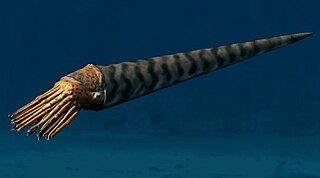
Orthoceras is a genus of extinct nautiloid cephalopod restricted to Middle Ordovician-aged marine limestones of the Baltic States and Sweden. This genus is sometimes called Orthoceratites. Note it is sometimes misspelled as Orthocera, Orthocerus or Orthoceros.

Orthoceratidae is an extinct family of actively mobile carnivorous cephalopods, subclass Nautiloidea, that lived in what would be North America, Europe, Asia, Africa, and Australia from the Ordovician through Triassic from 490—203.7 mya, existing for approximately 286.4 million years.

Orthocerida, also known as the Michelinocerida, is an order of extinct orthoceratoid cephalopods that lived from the Early Ordovician possibly to the Late Triassic. A fossil found in the Caucasus suggests they may even have survived until the Early Cretaceous, and the Eocene fossil Antarcticeras is sometimes considered a descendant of the orthocerids although this is disputed. They were most common however from the Ordovician to the Devonian.

Pseudorthocerida is an order of generally straight longiconic orthoceratoids with a subcentral to marginal cyrtochoanitic siphuncle composed of variably expanded segments which may contain internal deposits that may develop into a continuous parietal lining.. Cameral deposits are common and concentrated ventrally. Apices typically have a slight to moderate exogastric curvature
Baltoceratidae is an extinct family of orthoconic cephalopods belonging to the subclass Nautiloidea endemic to what would be Asia, Australia, Europe, North America, and South America during the Ordovician living from about 480–460 mya, existing for approximately 20 million years.

Geisonoceratidae is an extinct family of orthoceroid cephalopods endemic to what would be Asia, Europe, and North America from the Middle Ordovician to the Middle Devonian living from about 470—380 mya, existing for approximately 90 million years. With the possible addition of an Early Cretaceous orthocerid from the western Caucasus the range of this group increases dramatically to some 350 million years, thus making it one of the longest lived families of the Nautiloidea.

Paraphragmitidae is an extinct family of actively mobile aquatic carnivorous cephalopods belonging to the subclass Orthoceratoidea endemic to what would be Asia and Europe during the Silurian living from 436 to 418.7 mya, existing for approximately 17.3 million years.
Pseudorthoceratidae is an extinct family of actively mobile aquatic carnivorous cephalopods belonging to the subclass Orthoceratoidea endemic to what would be North America, Asia, and Europe during the Silurian living from 460.5—251 Ma, existing for approximately 209.5 million years.
Cyptendoceras is an extinct nautiloid cephalopod included in the family Ellesmeroceratidae that lived in what would be North and South America during the latter part of the Early Ordovician from about 475 – 472 mya, existing for approximately 3 million years.
Eosomichelinoceras is an extinct genus from the actively mobile carnivorous cephalopod family Baltoceratidae that lived in what would be Asia and South America during the Ordovician from 461—452 mya, existing for approximately 9 million years.

Cycloceras is an extinct nautiloid cephalopod genus from the Carboniferous of Western Europe, of unknown affinity with the Orthocerida.
Geisonocerina is an extinct genus from the carnivorous nautiloid cephalopod order Orthocerida that lived in what would be North America, Europe, and Asia during the Ordovician through Permian from 449 to 290 mya, existing for approximately 159 million years.
Mongoceras is an extinct orthoconic nautiloid cephalopod found in the Silurian of China and Siberia. It is included in the Orthocerida. The family in undetermined.
Paradnatoceras is an extinct straight-shelled cephalopod genus that lived in what would become China during the Ordovician from 478.6 to about 461 mya, existing for approximately 17.6 Ma.
Pseudorthocerataceae is an extinct superfamily of actively mobile carnivorous cephalopod, essentially a Nautiloid, that lived in what would be North America, Europe, Australia, and Asia during the Ordovician from 490—445.6 mya, existing for approximately 44.4 million years.
Tretoceras is an extinct genus of cephalopods included in the Orthocerida that lived in what would be Europe during the early Middle Ordovician, fossils of which have been found only in Austria.

Orthoceratoidea is a major subclass of nautiloid cephalopods. Members of this subclass usually have orthoconic (straight) to slightly cyrtoconic (curved) shells, and central to subcentral siphuncles which may bear internal deposits. Orthoceratoids are also characterized by dorsomyarian muscle scars, extensive cameral deposits, and calciosiphonate connecting rings with a porous and calcitic inner layer.
The Orthocerataceae is a superfamily of orthocerid cephalopods that lived from the late Early Ordovician to the Early Cretaceous, but is no longer in general use.
Jaochimoceras is a genus of orthoceroid cephalopods from the Silurian of Central Europe (Bohemia) named by Baskov, 1960, and included in the Geisonoceratidae. As with the orthocerids, its shell is longiconic, siphuncle more or less central, and chambers somewhat long.
Hesperoceras is an orthocerid cephalopod belonging to the subfamily Michelinoceratinae which comes from the lower Mississippian of New Mexico.




